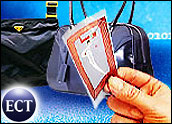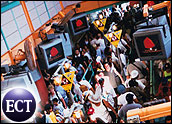
IBM recently announced that it will pour US$250 million into thedevelopment of radio frequency identification (RFID) and sensor networktechnology over the next five years.
In addition to developing hardware,including the wireless tags and readers, IBM also plans to providesoftware and integrated support systems that will allow vendors to trackgoods and monitor shipping schedules in a streamlined fashion.
“It’s about more than just RFID,” said Christine Overby, senior analystin consumer markets for Forrester Research. IBM’s investment will alsoinfluence its Sensors and Actuators Solutions business unit and otherRFID-linked technologies across IBM’s services, software and hardwaregroups.
Many see the method as the eventual replacement for traditional barcodesupply-chain tracking and inventory oversight. According to Overby’sresearch, 37 percent of IT decision makers expect that RFID deploymentswill increase over the next 12 months.
Equal Opportunity Deployment
The technology givesmanufacturers and the distribution outlets they serve continuousvisibility of the movement of goods in the supply chain and warehouseall the way through to delivery to customers. Because data stored in thetags includes such information as manufacture and expiration dates, foodand drug companies will have the benefit of checking the condition of perishable products while they are still on pallets.
Retail giant Wal-Mart has issued a directive for its suppliersrequiring them to employ radio tagging by January 2005, and the U.S.Department of Defense, Honeywell, Phillips and Michelin have alreadywidened their IT perspectives to embrace RFID as well. Andy Efstathiou,program manager at the Yankee Group, told CRM Buyer that smallerretailers and business-to-business organizations will not be left behind.
“Certainly IBM’s announcement will make RFID adoption more likely andmore easy,” he said. Small retailers will seize on the advances theirsuppliers, common to Wal-Mart, have made to comply with the uberstore’scommand and require an increasing portion of manufacturers to tag boxesand pallets arriving at their stores or warehouses.
Monitoring Products
“When you talk about smaller retailers, they’re certainly going to tryto benefit from having suppliers that have done this as a part ofsupplying to Wal-Mart. Most of that is going to be with management ofinventory in the back room and from the back room to the front room orthe store shelf,” he said.
In retailers large and small, problems occur with monitoring productmovement from the storeroom to the shelf, he said. Typically, thesupplier gets the signature of the clerk checking a product in at thereceiving dock, and all product movement is dutifully recorded up untilthat point, but some retailers still lose goods between their ownstorage space and the point of sale.
RFID would provide extra security and inventory accountability, but itsadoption could be a slow process. With IBM’s announcement, Efstathiousaid, the technology will be available and will be affordable.
“For IBM to make that kind of investment is going to reduce the cost ofadoption, and a much broader market will benefit from the technology,”he said.
Casing out RFID
In the early stages of adoption, boxes and pallets will carry radio tags but fewer individual consumerproducts will have such devices. As privacy concerns wane and middlewareand other supportive software surfaces are developed to usethe data RFID can provide, more and more smaller companies are likely toget involved in the trend.
“I believe the sporting goods retail industry is a little behind in thisinitiative,” Jeff Raltz, manager of engineering for Dick’s SportingGoods, told CRM Buyer. “We’ve explored it but haven’t found RFID as agood fit yet. We worked on a project at Galyans last year in one of ouroperations to determine the benefits of RFID. At that time it didn’tdeliver enough for us to proceed.”
But Raltz said that as large retailers like Wal-Mart and Target get theirdeployments in place, Dick’s will fall in line. “Sporting goods couldfollow suit but not for a while,” he said.
“A lot would depend on whichWal-Mart and Target vendors participate. From a sporting goods retailperspective, Wal-Mart and Target are the giants in comparison to Dick’sand the Sports Authority/Gart’s.”
Smaller competitors will follow at some point, he said. “I’vebeen to enough conferences to see that RFID is the wave of the future,but I don’t know if there is enough penetration for this to happen inthe near term,” Raltz concluded.





















































Social CRM
See all Social CRM